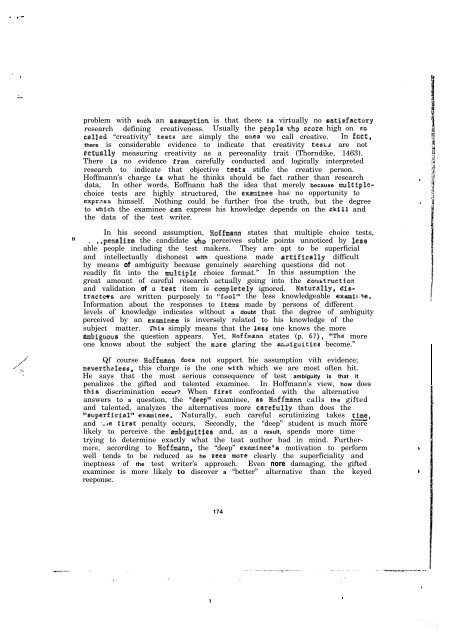Technical Report - International Military Testing Association
Technical Report - International Military Testing Association
Technical Report - International Military Testing Association
You also want an ePaper? Increase the reach of your titles
YUMPU automatically turns print PDFs into web optimized ePapers that Google loves.
c r-<br />
’<br />
,<br />
L-<br />
.’ ./’<br />
/ :‘..<br />
problem with such an assumption is that there i.8 virtually no satiafsctory<br />
research defining creativeness. Usually the peopie GAO Gcore high on co<br />
call.ed “creativity” test6 arc simply the one0 we call creative. In fact,<br />
there is considerable evidence to indicate that creativity testd are not<br />
actually measuring creativity as a pereonality trait (Thorndike, 1463).<br />
There is no evidence from carefully conducted and logically interpreted<br />
research to indicate that objective teats stifle the creative person.<br />
Hoffmann’s charge ie what he thinks should be fact rather than research<br />
data, In other words, Eoffnann ha8 the idea that merely because multiplechoice<br />
tests are highly structured, the exminee has no opportunity to<br />
expr.?ss himself. Nothing could be further fros the truth, but the degree<br />
to h%ich the examinee ten express his knowledge depends on the skill and<br />
the data of the test writer.<br />
In his second assumption, Hoffmann states that multiple choice tests,<br />
1, . ..penalize the candidate uho perceives subtle points unnoticed by less<br />
able people including the test makers. They are apt to be superficial<br />
and intellectually dishonest with questions made artifically difficult<br />
by means of ambiguity because genuinely searching questions did not<br />
readily fit into the rmrltiple choice format.” In this assumption the<br />
great amount of careful research actually going into the construction<br />
and validation of a teet item is cmpletely ignored. Natur.tlly, distr8ctor6<br />
are written purposely to “fool” the less knowledgeable examil.se.<br />
Information about the responses to iterns made by persons of different<br />
levels of knowledge indicates wlthout a doubt that the degree of ambiguity<br />
perceived by an exuainee is inversely related to his knowledge of the<br />
subject matter. ‘fiftl simply means that the less one knows the more<br />
ambiguoue the question appears. Yet, HoffmaM states (p. 67), “The more<br />
one knows about the subject the rare glaring the a;tilguitice become.”<br />
Qf course Hoffmann dccs not support hie assumption vith evidence;<br />
nevertheless, this charge is the one wit.h which we are most often hit.<br />
He says that the most serious consequence of test ambiguity is that it<br />
penalizes the gifted and talented examinee. In Hoffmann’s view, how does<br />
this discrimination occur? When first confronted with the alternative<br />
answers to a question, the “deep” examinee, as Hoffrrann calls the gifted<br />
and talented, analyzes the alternatives more carefu2ly than does the<br />
l’superficialt’ exnminee. Naturally, such careful scrutinizing takes time,<br />
and :-Be first penalty occurs, Secondly, the “deep” student is much more<br />
likely to perceive the rrmbiguitlee and, as a result, spends more time<br />
trying to determine exactly what the teat author had in mind. Furthermore,<br />
according to Hoffmann, the “deep” examince’s motivation to perform<br />
well tends to be reduced as he sees more clearly the superficiality and<br />
ineptness of the test writer’s approach. Even nore damaging, the gifted<br />
examinee is more likely to discover a “better” alternative than the keyed<br />
reeponse.<br />
%<br />
174<br />
.<br />
-____-- - _.<br />
.<br />
.<br />
.









